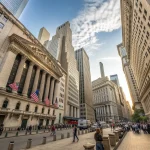The S&P 500 Index has gained 1% so far this year. This comes after the index fell into correction territory in March. President Trump’s choice to roll back some tariffs and pause others has given investors more confidence.
However, the tariffs put in place by the Trump administration have raised the average tax on U.S. imports to 14.4%, according to JPMorgan Chase. This is six times higher than when Trump took office and the highest since 1939. Some well-known financial experts have shared their worries about the current trade policies.
Hedge fund billionaire Bill Ackman said the administration’s trade policies could lead to an “economic nuclear winter.” JPMorgan CEO Jamie Dimon also warned that higher tariffs would raise consumer prices and slow economic growth. Wall Street analysts have given a somewhat surprising answer about whether the stock market will crash or soar in the second half of 2025. The market is currently in wait-and-see mode as investors look for signs of economic trouble.
Some cracks are starting to show in the U.S. economy. In May, consumer sentiment fell to its second-lowest level ever, and inflation expectations rose to their highest since 1981, according to the University of Michigan. The first-quarter report said “the U.S. may be closer to a recession than expected.” JPMorgan strategists noted that a tariff-driven jump in imports pulled real growth down by 0.3% annualized.
A recent Wall Street Journal survey of 64 economists put the chances of a recession in the next 12 months at 45%, up from 22% in January. Analysts have also lowered their earnings estimates since President Trump took office. In January, the consensus estimate predicted 14% earnings growth in 2025.
Wall Street cautious amid evolving tariffs
Now, analysts expect only 8.5% earnings growth, according to LSEG. This year has seen unprecedented levels of economic uncertainty.
The future likely holds more of the same, at least until the Trump administration provides more clarity on U.S. trade policy. At that point, things could either get much better or much worse, depending on the context. Wall Street expects the stock market to trade sideways for the rest of 2025.
In December, the S&P 500 had a median year-end target of 6,600 among 17 investment banks and research groups. However, most have since revised their forecasts lower, setting a new median year-end target of 5,900. This suggests a 1% downside from the current level of 5,945.
It means Wall Street basically predicts the stock market will end the year where it began. However, this outlook could change as trade policies evolve and new economic data comes out. The second estimate for Q1 GDP will be released on Thursday, May 29.
Consumer spending and personal consumption expenditure price-index inflation (the Federal Reserve’s preferred measure) will be published on Friday, May 30. Shortly after, investors will get data on May job openings on Tuesday, June 3, followed by May payroll and unemployment numbers on Friday, June 6. Stocks could see significant volatility as these reports come out.
So investors should prepare for potential market swings even if Wall Street expects a flat market for the rest of 2025.







